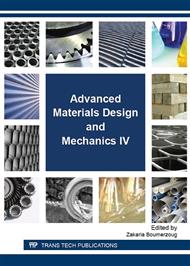[1]
H.W. Swift, Plastic instability under plane stress, J. Journal of the mechanics and Physics of solid. 1 (1952) 1-18.
Google Scholar
[2]
R. Hill, On discontinuous plastic states with special reference to localized necking in thin sheets, J. Journal of the mechanics and Physics of solid. 1 (1952) 19-30.
DOI: 10.1016/0022-5096(52)90003-3
Google Scholar
[3]
Z. Marciniak, K. Kuczynski, Limit strains in the processes of stretch-forming sheet metal, J. International Journal of Mechanical Science. 9 (1967) 609-620.
DOI: 10.1016/0020-7403(67)90066-5
Google Scholar
[4]
G.S. Ma, M. Wan, X.D. Wu, Theoretical prediction of FLDs for Al-Li alloy at elevated temperature based on M-K model, J. Chinese Journal of Nonferrous Metals. 18 (2008) 980-984.
Google Scholar
[5]
M. Yang, X.H. Dong, The Forming Limit Prediction Using a Rate-Dependent Crystal Plasticity Model, J. Journal of ShangHai JiaoTong University. 42 (2008) 720-723.
Google Scholar
[6]
P.M. Du, L.H. Lang, B.S. Liu, Theoretical prediction and parameter influence of FLDs based on M-K model, J. Journal of Plasticity Engineering. 18 (2011) 84-89.
Google Scholar
[7]
R. Safdarian, Forming limit diagram prediction of tailor welded blank by modified M–K model, J. Mechanics Research Communications. 63 (2015) 47-57.
DOI: 10.1016/j.mechrescom.2015.05.004
Google Scholar
[8]
X.Y. Yang, L.H. Lang, K. N Liu, Modified MK model combined with ductile fracture criterion and its application in warm hydroforming, J. Transactions of Nonferrous Metals Society of China. 25 (2015) 3389-3398.
DOI: 10.1016/s1003-6326(15)63974-7
Google Scholar
[9]
A. Needleman, N. Triantafyllidis, Void growth and local necking in biaxially stretched sheets, J. Journal of Engineering Materials and Technology. 100 (1978) 164-169.
DOI: 10.1115/1.3443466
Google Scholar
[10]
L. Gao, G.Q. Tong, Y. Guo, Surface roughness evolution and formability of IF sheet steel to grain size and sheet thickness, J. Transactions of NUAA. 1 (1999) 16-23.
Google Scholar
[11]
G.N. Chen, S.G. Hu, Damage, Instability and Construction of Forming Limit Curve in Sheet Metal Stretch Forming , J. Journal of Plasticity Engineering. 1 (1994) 31-46.
Google Scholar
[12]
A. Kami, B.M. Dariani, Numerical determination of the forming limit curves of anisotropic sheet metals using GTN damage model, J. Journal of Materials Processing Technology. 216 (2015) 472-483.
DOI: 10.1016/j.jmatprotec.2014.10.017
Google Scholar
[13]
S. Strören, J.R. Rice, Localized necking in thin sheets, J. Journal of the Mechanics and Physics of Solid. 23 (1975) 421-441.
Google Scholar


